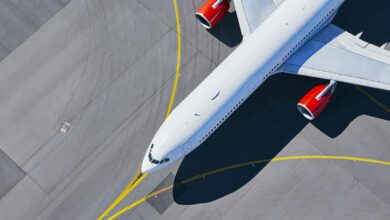
An American Airlines Boeing 787 Dreamliner needs repairs after a lightning strike significantly damaged its fuselage. A photo of the plane was shared on social media, catching the attention of nearly 200,000 people.
The incident happened Monday, February 20th, when N839AA, a 787-9, was traveling from Tokyo to Dallas/Fort Worth. The aircraft is reportedly being worked on to be restored back to operational condition.
Details of the incident
According to data from FlightAware, the aircraft was operating as American Airlines flight 60 from Tokyo Narita Airport to Dallas/Fort Worth International Airport. It is unclear when the plane was struck by lightning during its nearly 11-hour journey back to the US. N839AA is currently at a maintenance hangar at DFW airport as it undergoes repairs, according to social media. The aircraft was delivered to American in October 2018.
Airplanes are susceptible to lightning strikes year-round, but the summertime is when they usually occur due to the number of thunderstorms. Pilots typically try to avoid thunderstorm clouds, but in other instances, they may have to fly through a thunderstorm, which increases the risk of a possible lightning strike.
When does lightning strike?
Thunderclouds can appear in various altitudes during flight, but lightning strikes most often occur during takeoff or before landing when the aircraft is at a reduced altitude. The highest probability for lightning attachment to an airplane is the outer extremities, such as the wing tip, nose, or rudder, according to Jetline Marvel. Lightning strikes mainly occur during the climb and descent phases of flight between an altitude of 5,000 to 15,000 feet (1,524 to 4,572 m). When an aircraft is above 20,000 feet (6,096 m), the probability of a lightning strike is decreased significantly.
When the plane is hit, the strike can be seen and heard in the cockpit, prompting pilots to ensure that all devices, such as radios, are not damaged and work normally. Pilots then report the lightning strike to technical staff, and then a thorough inspection is performed on the aircraft, according to Air Live.
The external parts of most commercial aircraft are made of metal and are thick enough to withstand a lightning strike. The fuselage is the primary defense, as the surface is sufficient to shield the plane’s interior from lightning strikes. The metal skin also prevents electromagnetic energy from entering the airplane’s electrical system and wiring. It does not prevent all electromagnetic radiation from entering the electrical wire but keeps it manageable.
Dreamliner lightning problem?
On average, every commercial plane is struck by lightning at least once a year. According to View from the Wing, it has been over 40 years since a crash has been attributed to a lightning strike as the strong fuselage of the plane conducts electricity and generally transmits the strike out the tail.
Despite a strong and thick fuselage, the 787 reportedly has a known issue with lightning strikes. In 2019, Boeing reduced lightning protection in the wings of some 787s to reduce costs and speed up deliveries, but the company reportedly said that safety was not compromised. In May, a Jetstar 787 was grounded after sustaining extensive damage from a lightning strike.
Sources: Air Live, Jetline Marvel, View from the Wing


.jpg)



